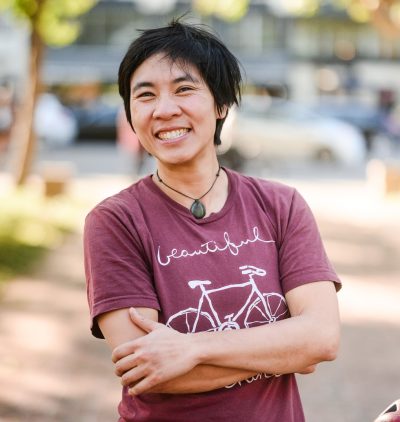New Leadership at Bike East Bay Centers Mobility Justice
4:36 PM PDT on June 16, 2022

Bike East Bay’s outgoing Executive Director Ginger Jui. Photo by Malcolm Wallace
Editor's Note: Bike East Bay works for better biking conditions in Alameda and Contra Costa Counties, which include some 33 incorporated cities and numerous unincorporated areas. Over time, its mission has grown from its beginnings as a scrappy group of bike riders mapping out the best bike routes and demanding that bikes be allowed on BART. Its work now encompasses safety, infrastructure, policy, education and training, and advocating for equity and mobility justice within the communities it serves.
Bike East Bay recently announced that its current Executive Director, Ginger Jui, will depart in December. Rather than hiring a new Executive Director, Bike East Bay plans to transition to leadership by Co-Executive Directors as part of a larger strategy of centering equity in its bicycle advocacy work. To that end, the organization is embarking on a search to hire a Co-Executive Director of Mobility Justice to serve alongside a Co-Executive Director of People and Operations.
Below, Ginger Jui reflects on this plan, what it means for Bike East Bay, and what it could mean for bike advocacy in general.
As the outgoing Executive Director of Bike East Bay, I am supporting this leadership transition to deepen our commitment to transportation justice and racial equity in bicycle advocacy. I know intimately how our personal identities as people of color, immigrants, women and transgender folks means we face barriers to fully participating in the transportation and urban planning sectors. As a nonbinary gender and immigrant Asian leader in a white-dominated advocacy space, it has been very important for me to build a more inclusive and equity-focused bike movement.
Bike East Bay seeks to drive innovation for racial equity and social justice in the wider bicycle advocacy movement in our shift to leadership by Co-Executive Directors. This change represents two innovations for our bicycle advocacy nonprofit. First, we are investing in a mobility justice lens at the highest level of the organization. Second, we are aligning our staff structure with our values for shared leadership and collaborative decision-making.
Mobility Justice through Intersectional Bicycle Advocacy
Bike East Bay is well-known for its advocacy for building great bike lanes to get around town. Yet bike lanes are frequently not enough — and at times, not even the right solution — when it comes to addressing safe urban mobility.
We encounter examples everyday of the systemic barriers and oppressions that impair mobility for marginalized communities. What is the best bicycle advocacy solution for a mom who doesn’t want her Black son biking to work because he will be racially profiled by cops? Or the auntie who is scared to shop in Chinatown after another racist attack? For the commuter who lives in Stockton but works the night shift in Oakland?
Over the past several years, we have seen the need to grow our policy expertise and coalition partnerships to address urgent regional issues. Mobility justice recognizes and amplifies the fact that racism and white supremacy, sexism, classism and able-ism all interact to segregate and exclude members of society from opportunity. Our advocacy team is constantly considering how our campaigns for safe and bikeable streets interact with disability access, public transit, housing and displacement, racially-biased police enforcement, and sustainability.
In 2020, Bike East Bay began working with the Anti-Police Terror Project, the City of Oakland’s Reimagine Public Safety Task Force, and other partners to remove traffic enforcement duties from armed police in cities around the East Bay and transfer the responsibility for traffic safety to city transportation departments. We hope to build towards a statewide coalition to pass state legislation to make this change possible.
Our advocacy staff also see every day that marginalized communities have a lot less influence over changes in our neighborhoods. In one of our campaigns in Alameda County, for example, the city removed a protected bike lane from plans to improve a street near a popular local park and recreation center. They made this decision without consulting the predominantly Spanish-speaking community that supported the street improvement.
Many examples like this show what marginalized communities know intimately: that your skin color, housing situation, and mental health status affects your mobility. You might be more likely to be hit by a car, assaulted in a racist attack, or shot by a cop when you’re getting around town. If we do not address the diverse range of reasons why people do not feel comfortable riding around town, bicycle advocates will continue to systematically exclude people of color and other marginalized communities from the benefits of active and sustainable transportation.
Systemic barriers need systemic solutions. And here is where Bike East Bay’s grassroots member base makes us unique in the local advocacy ecosystem. Whether gathering for a bike ride or turning up at city hall, Bike East Bay’s members and supporters naturally come together around bicycling as a community organizing tool.
Bike East Bay’s new Co-Executive Director of Mobility Justice will take this community organizing to the next level. We hope to leverage expertise in mobility justice to connect with new partners and coalitions to tackle systemic barriers to healthy, sustainable mobility. Sharing the joy of bicycling is not only an end goal. We are mobilizing by bike for transportation justice, which means more and better biking for everyone.
Smash Patriarchy and Build Resilience with Co-Leadership
In sharing the executive role across two Co-Executive Directors, Bike East Bay is following in the footsteps of other organizations in the social justice space that have made the shift to co-leadership models. Two factors are driving this change across the sector: to make the Executive Director role more sustainable, and to promote anti-oppressive practices through shared leadership.
Bike East Bay is led here by our values for equity and social justice. Our positive and supportive staff culture is rooted in collaboration and shared leadership. In contrast, the traditional executive director role is based in a patriarchal and unsustainable model of leadership. Under a traditional hierarchy, decision-making power is concentrated in one person, who leads the organization with their vision via unquestioned authority. This leadership model reflects the problematic ways in which transportation planning decisions are made: unilaterally, often by government agencies or powerful elected officials without input or understanding of the needs of the community.
Shared leadership values are a reflection of how Bike East Bay aims to build a more equitable and well-functioning transportation system. By shifting to a Co-Executive Director model, we align our internal practices with our work to share leadership and build collective power across our communities.
Far from being a single voice for the bike movement, Bike East Bay is a hub that facilitates thriving partnerships across the regional advocacy ecosystem. We are community organizers who work to build leadership capacity. We actively collaborate in decision-making across staff, members, volunteers, and our partners in the community.
Co-leadership is also a strategy for preventing burnout and investing in stability and resilience as an organization. I have become unsustainably overwhelmed a number of times in my four years as a first-time executive director. This is pretty typical for nonprofit leaders, especially at small and under-resourced bicycle advocacy organizations. Executive directors take on enormous responsibilities, from advocacy to administration. A lot of us burn the candle at both ends to keep the organization going.
I have always managed to bounce back, thanks to the support of our staff and board (and some good time spent biking in the woods). However, the true game changer happened after Bike East Bay hired an Operations Director, Jill Holloway. I finally had a thought partner who could also connect the day-to-day workings of the organization to our high-level strategic plan. Jill holds me accountable to the hardest things we are working on, such as increasing staff wages to match the Bay Area’s cost of living and building an equity lens into every aspect of our workplace and advocacy strategies.
In partnership with Jill as our Operations Director (and future Co-Executive Director of People and Operations), I am building working systems for co-leadership to support the incoming Co-Executive Director of Mobility Justice.
Together, these two roles will lead the organization in an equity-centered bicycle advocacy strategy based on three core values:
- Transportation Justice
- Community Organizing
- Leadership by People of Color
Externally, the Co-Executive Director of Mobility Justice will deepen our impact and thinking on mobility justice through advocacy strategy, community organizing, and partnerships. Internally, the Co-Executive Director of People and Operations will center equity in hiring and staff culture.
Leading Together
By sharing our leadership process with the active transportation community, I hope to inspire more advocacy organizations to elevate equity-focused staff roles to positions of full leadership and decision-making power. At the same time, I ask you to consider how these positions can also generously share leadership and actively undo inequitable power structures.
I am excited to put theory to practice over the next several months as Bike East Bay searches for a new mobility justice leader to propel its work. With the support of the wider advocacy community, Bike East Bay is excited to grow our people- and pedal-powered movement for a more sustainable and equitable transportation system.
How you can help:
Share Bike East Bay’s Co-Executive Director of Mobility Justice job description.
We would love to hear your feedback and questions about Bike East Bay’s leadership transition. Let us know here!
For further reading on mobility justice, we are grateful to the generous thought leadership from many organizations, including:
- The Untokening Collective’s Principles of Mobility Justice
- PolicyLink’s California Mobility Justice Advocates Guiding Principles
- Safe Routes Partnership’s Taking Steps toward Mobility Justice
Streetsblog California editor Melanie Curry has been thinking about transportation, and how to improve conditions for bicyclists, ever since commuting to school by bike long before bike lanes were a thing. She was Managing Editor at the East Bay Express, editor of Access Magazine for the University of California Transportation Center, and earned her Masters in City Planning from UC Berkeley.
Read More:
Stay in touch
Sign up for our free newsletter
More from Streetsblog California
State E-bike Incentive Program Update
E-bike battery certification requirements, and get ready now for the first launch window.
Commentary: Merchants Are Getting People Killed
The number one local obstruction to curbing traffic violence is local commerce and merchant groups.
Freeway Drivers Keep Slamming into Bridge Railing in Griffith Park
Drivers keep smashing the Riverside Drive Bridge railing - plus a few other Griffith Park bike/walk updates
Wednesday’s Headlines
Bike Month begins; Transit dangers; Yolo causeway project "not air quality concern" and Sacramento gets an F in air quality; Universal basic income could get a lot of people off the streets; More




